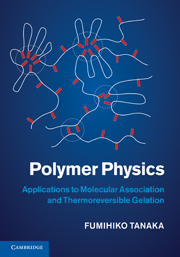Book contents
- Frontmatter
- Contents
- Preface
- 1 Statistical properties of polymer chains
- 2 Polymer solutions
- 3 Classical theory of gelation
- 4 Elasticity of polymer networks
- 5 Associating polymer solutions and thermoreversible gelation
- 6 Nongelling associating polymers
- 7 Thermoreversible gelation
- 8 Structure of polymer networks
- 9 Rheology of thermoreversible gels
- 10 Some important thermoreversible gels
- Index
Preface
Published online by Cambridge University Press: 16 May 2011
- Frontmatter
- Contents
- Preface
- 1 Statistical properties of polymer chains
- 2 Polymer solutions
- 3 Classical theory of gelation
- 4 Elasticity of polymer networks
- 5 Associating polymer solutions and thermoreversible gelation
- 6 Nongelling associating polymers
- 7 Thermoreversible gelation
- 8 Structure of polymer networks
- 9 Rheology of thermoreversible gels
- 10 Some important thermoreversible gels
- Index
Summary
Polymer science has expanded over the past few decades and shifted its centre of interest to encompass a whole new range of materials and phenomena. Fundamental investigations on the molecular structure of polymeric liquids, gels, various phase transitions, alloys and blends, molecular motion, flow properties, and many other interesting topics, now constitute a significant proportion of the activity of physical and chemical laboratories around the world.
But beneath the luxuriance of macromolecular materials and observable phenomena, there can be found a common basis of concepts, hypotheses, models, and mathematical deductions that are supposed to belong to only few theories.
One of the major problems in polymer physics which remain unsolved is that of calculating the materials properties of self-assembled supramolecules, gels, molecular complexes, etc., in solutions of associating polymers from first principles, utilizing only such fundamental properties as molecular dimensions, their functionality, and intermolecular associative forces (hydrogen bonding, hydrophobic force, electrostatic interaction, etc.).
Theoretical studies of polymer association had not been entirely neglected, but their achievements were fragmentary, phenomenological, and lacked mathematical depth and rigor. What I have tried to do, therefore, is to show how certain physically relevant phenomena derive from the defining characteristics of various simple theoretical model systems.
The goal of this book is thus to present polymer physics as generally as possible, striving to maintain the appropriate balance between theoretical descriptions and their practical applications.
- Type
- Chapter
- Information
- Polymer PhysicsApplications to Molecular Association and Thermoreversible Gelation, pp. xiii - xviPublisher: Cambridge University PressPrint publication year: 2011

